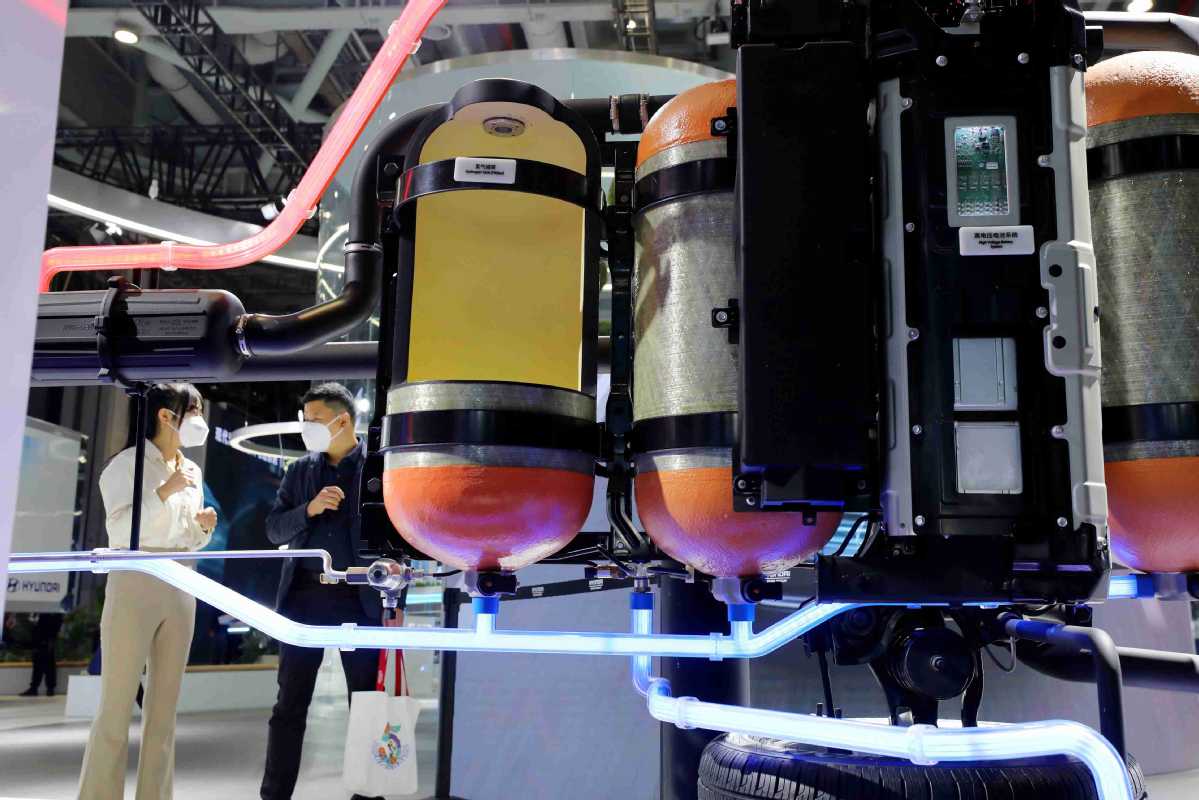Visitors check out hydrogen fuel cell technologies that help power vehicles during the fifth China International Import Expo in Shanghai on Nov 6, 2022. [Photo/Xinhua]
Substantial growth prospects exist for hydrogen rail traffic in China, which would drive an industrial chain of up to trillions of yuan and further facilitate the country's carbon neutrality ambitions, said industry experts.
Hydrogen energy has broad application scenarios in rail transit in China, including sightseeing trains and urban transit vehicles, as well as many engineering vehicles, said Chen Weirong, dean of the School of Electrical Engineering at Southwest Jiaotong University
"As China aims to peak carbon dioxide emissions by 2030 and achieve carbon neutrality by 2060, governments at all levels are making efforts to promote the hydrogen energy industry, laying out specific hydrogen development plans to drive the industry," Chen said during a recent forum.
"As a high potential energy source for buses and heavy goods vehicles and trains, hydrogen-powered vehicles are well positioned to help China reach its emission reduction goals as a versatile zero-emission technology in rail transportation. Capable of replacing diesel volumes at a large scale by 2030, the clean fuel is expected to drive an industrial chain of up to trillions of yuan in the years to come," he said.
Diesel locomotives account for more than one-third of the country's total, undertaking major railway construction tasks, and the national electrification rate has just exceeded 70 percent, Chen said.
Chinese industrial giant CRRC Corp Ltd, in partnership with Chengdu Rail Transit, introduced a new zero-emissions passenger train powered by hydrogen in February. The new train offers a travel range of 600 kilometers and is the fastest to date, with a top speed of 160 kilometers per hour.
The CRRC train uses hydrogen to generate electricity in its fuel cells, emitting nothing but water as a byproduct of the power generation process.
Chen said the application of hydrogen energy in rail transportation started as early as 2002. A significant milestone was the development of a light rail train by French company Alstom in 2018, which was officially put into commercial operation in Germany last year at a speed of 140 km/h. Siemens also developed a high-speed train last year with a speed of 160 km/h, which is currently undergoing testing and expected to be put into commercial operation next year.
"However, in China, we still need the support of policies and breakthroughs in many technical standards," he said.
As part of the nation's efforts to achieve the dual carbon goals, China aims to have 1 million hydrogen fuel cell vehicles and 1,000 hydrogen refueling stations by 2030.
The China Hydrogen Alliance estimates that green hydrogen will take up more in the energy mix, from 1 percent in 2019 to 10 percent by 2030, and the market scale will have increased nearly 30 times by then, which would require the production of at least 5 million tons of hydrogen per year.
To support the development of hydrogen in China, the government has launched various initiatives, including financial incentives, research and development funding and regulatory support. In addition, some Chinese companies have begun to invest in hydrogen-related projects, such as fuel cell vehicles, hydrogen refueling infrastructure and green hydrogen production, Chen said.
Peng Chaocai, vice-president at Sungrow Power Supply Co Ltd, said the development of hydrogen in China, as with any new technology, is subject to various challenges and uncertainties, including high production costs, limited infrastructure and the need for breakthroughs in key technologies.
However, with the support of government policies and the efforts of companies and researchers, the development of hydrogen in China is expected to continue to grow in the coming years, Peng said.
Liu Wei, secretary-general of China Hydrogen Alliance, said it is necessary to promote the large-scale application of green hydrogen in the industries of steel, chemicals and transportation, while further supporting large-scale green hydrogen trading, where green hydrogen can finally replace traditional fossil fuels such as crude oil.
Source: By Zheng Xin, chinadaily.com, Apr. 18, 2023 [https://global.chinadaily.com.cn/a/202304/18/WS643dedb9a310b6054face2cf.html]


